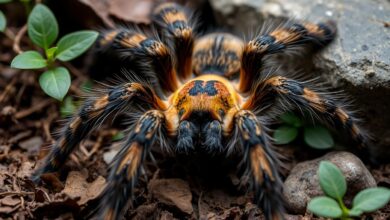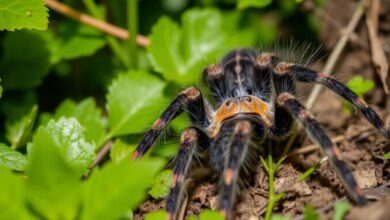Tarantula Feeding: Insects and Prey
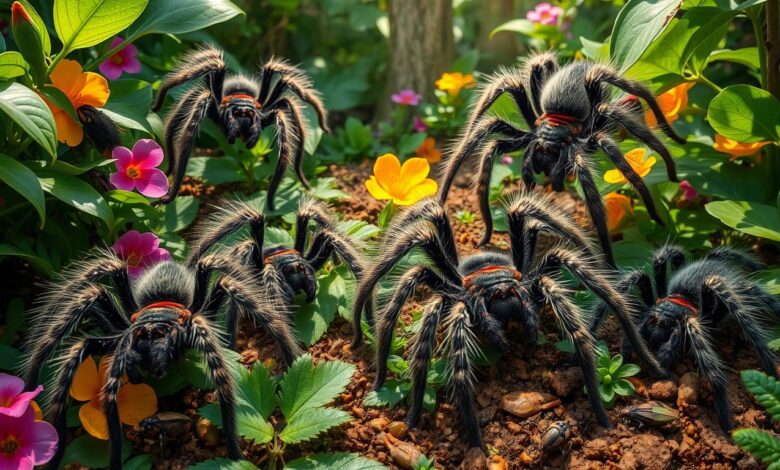
Tarantulas are fascinating spiders known for their size and interesting ways. They live in warm places and some cooler areas too. These spiders are mostly active at night, looking for food like insects, small mammals, and other spiders.
Even though they look scary, tarantulas are not very dangerous to humans. Their bites hurt, but they’re not deadly. Their venom isn’t as strong as some smaller spiders’. This makes them interesting to scientists and people who love learning about them.
Tarantulas have cool ways of hunting and go through a special process called molting. Exploring their world shows us how amazing arachnids are. You’ll learn a lot that will make you more curious and appreciate the variety of life on Earth.
Tarantulas: Fascinating Arachnids
Tarantulas are big, hairy spiders that belong to the family Theraphosidae. They are known for their strong bodies and thick, hairy skin. You can find them in tropical and subtropical areas, and some even live in deserts or temperate places.
Scientific Classification and Appearance
Taxonomically, tarantulas are classified as arthropods. This group includes many spiders with jointed legs and chelicerae (mouthparts). They come in a variety of colors, like bright blues and greens, or earthy tones, with detailed patterns on their bodies.
Habitat and Adaptation
Tarantulas are mostly nocturnal, meaning they are active at night. They hunt for insects, small mammals, and other spiders then. Their underground homes offer them safety and protection, especially when they shed their skin to grow.
Even though they look scary, tarantulas are not a big threat to people. Their bites hurt, but their venom isn’t as strong as some smaller spiders’. These arachnids are still very interesting to scientists and fans.
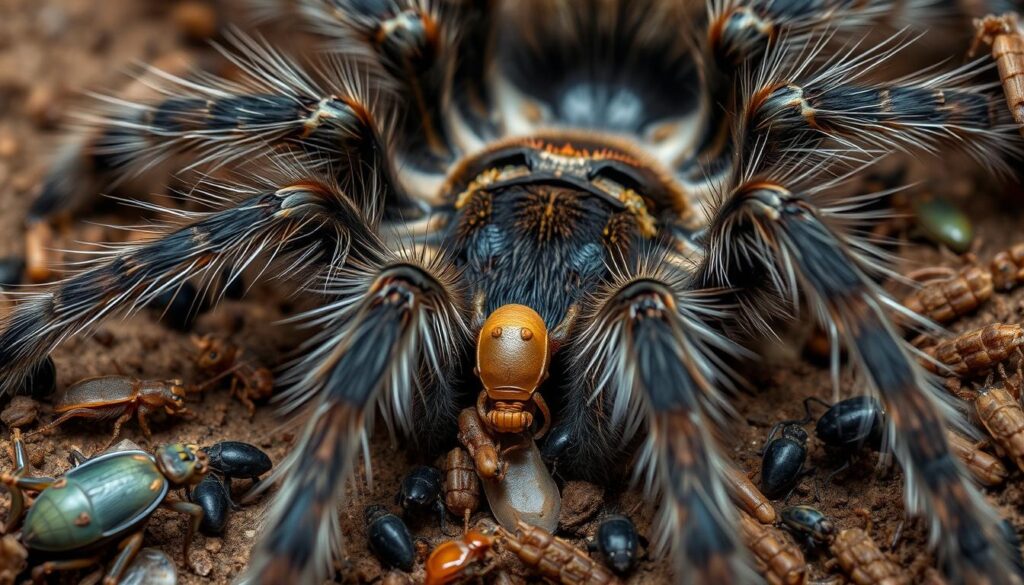
Insects for Tarantulas: A Diverse Diet
Tarantulas are fascinating arachnids with a wide variety of foods. They eat insects, small mammals, and even other spiders. Their diet includes crickets, mealworms, and roaches. These predators use their speed and strong jaws to catch and eat their food.
Dietary Preferences
Tarantulas are opportunistic hunters. They eat many insects and small arthropods. What they eat can change based on the species and what’s available in their habitats. Some common foods are:
- Crickets
- Mealworms
- Roaches
- Small beetles
- Grasshoppers
Hunting Techniques
Tarantulas use different ways to catch their prey. Some wait patiently for their food to come close. Others chase after their prey, using their speed and agility.
These arachnids use their strong jaws to eat their insect food. Their way of eating is interesting and important for their role as predators in their ecosystems.
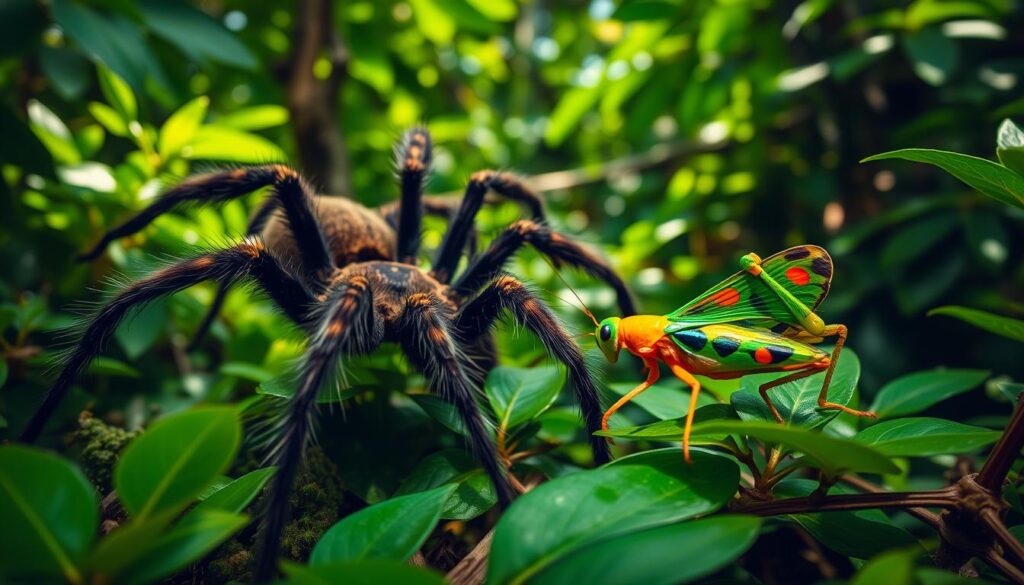
| Prey Preference | Hunting Technique |
|---|---|
| Crickets, mealworms, roaches | Ambush, active pursuit |
| Small beetles, grasshoppers | Ambush, active pursuit |
| Small mammals, other spiders | Ambush, active pursuit |
The Speed of Tarantulas
In the world of tarantulas, their speed is truly amazing. These arachnids can move up to 10 miles per hour. This is impressive for their size and strength. They use this speed to catch food and avoid dangers.
Tarantulas are amazing arthropods because of their speed. Their long legs and quick movements let them run fast. This makes them great predators in their homes. They can also quickly get away from dangers, helping them survive.
| Tarantula Species | Average Speed (mph) |
|---|---|
| Ceratogyrus marshalli | 8 |
| Poecilotheria regalis | 10 |
| Aphonopelma hentzi | 6 |
The speed of tarantulas shows how well they have adapted over time. It also highlights the amazing variety of spiders in nature. Learning about their speed helps us see the beauty of life around us.
Symbiotic Relationships
The world of nature is full of connections that go beyond just tarantulas living alone. These amazing arachnids work together with other animals, living in a balance. This balance is key to their survival.
Coexistence with Ants
Many people think ants and tarantulas are enemies. But, surprisingly, ants often let tarantulas live. This is because the tarantulas have a special hair covering. This hair stops the ants from biting or stinging them.
But not all tarantulas are safe from ants. Some, like the Avicularia hirschii, have found other ways to stay safe. They live on the edge of leaves, away from the ants.
Amphibian Companions
Tarantulas don’t just work with ants. They also live with amphibians. These spiders share their homes with amphibians. This helps the amphibians stay safe from harm.
| Symbiotic Relationship | Benefit to Tarantulas | Benefit to Other Species |
|---|---|---|
| Coexistence with Ants | Thick hair protects against ant bites and stings | Ants avoid confrontation with the tarantulas |
| Amphibian Companions | Shelter and protection from predators | Amphibians receive shelter and protection from harmful insects |
The tarantula’s skill in making symbiotic bonds shows how adaptable and strong they are. By living with other animals, they help themselves and make their ecosystems richer and more diverse.
Defense Mechanisms
Tarantulas are fascinating arachnids with a special defense. Their thick, hairy bodies protect them from predators. This hair acts like armor, keeping them safe from smaller creatures.
Studies show that their hair stops ants and other small predators from biting or stinging them. Army ants often ignore tarantulas and their babies when foraging for food. This is because they can’t bite or sting through the tarantulas’ hairy skin.
Some tarantulas, like the Avicularia hirschii in Peru, have another defense. They live in trees and avoid ants by hanging on leaves. They don’t have much hair, so this is how they stay safe.
Tarantulas also have other ways to defend themselves. Many burrowing tarantulas cover their eggs with urticating hairs to keep predators away. Some can also release defensive secretions or barbed hairs to scare off attackers.
The hairy armor of tarantulas shows how well they’ve adapted over time. This protection not only keeps them safe from small predators. It also shows how nature’s design can be incredibly clever. Exploring spiders and arthropods reveals the amazing ways tarantulas defend themselves.
Myths and Misconceptions
Tarantulas are often misunderstood because of myths and misconceptions. Many think they are dangerous and can kill with one bite. But, their bite hurts, but it’s not usually deadly. Their venom is not as strong as some smaller spiders.
Some believe tarantulas are aggressive and will bite without reason. However, they are usually calm and avoid fights. They only act defensively when they feel threatened.
Many think tarantulas are venomous, but it’s not quite true. They do have venom, but it’s mainly for catching food like insects and small rodents. It’s not dangerous to humans.
Tarantulas are actually interesting creatures that live in many places, from rainforests to deserts. Their true nature is often misunderstood, leading to wrong fears and myths.
Learning the truth about tarantulas helps us see how amazing and adaptable they are. By understanding them better, we can appreciate their unique place in the world.
Tarantula Species Diversity
Tarantulas are fascinating spiders in the Theraphosidae family. They have over 1,100 known species worldwide. Each species has unique adaptations and behaviors, fitting perfectly into its habitat. The Avicularia hirschii and the Galeodes arabs are two examples of this diversity.
Avicularia hirschii
Avicularia hirschii lives in the trees of Peru. It has a special way to avoid being eaten. These spiders hang on leaf edges, using their looks and quickness to hide from ants.
This behavior helps them live in the trees without being seen. They blend in with the leaves very well.
Galeodes arabs
The Galeodes arabs, or Egyptian giant solpugid, lives in the Middle East. It’s not a true spider but a different kind of arthropod. These spiders are fast and fierce, hunting insects, small animals, and even other spiders.
Tarantulas and their relatives show how amazing nature can be. From the tree-dwelling Avicularia hirschii to the fast Galeodes arabs, they fascinate scientists and nature lovers.
Nocturnal Hunting Behavior
Tarantulas are nocturnal creatures, hunting at night. This lets them avoid the daytime heat. They use the darkness to hunt better. They catch and subdue insects, small mammals, and even other spiders with their speed and powerful jaws (chelicerae).
The Galeodes arabs, or camel spider, is a notable arachnid for its hunting at night. These arthropods can be up to 6 inches long and weigh about 2 ounces. They can run up to 10 miles per hour. They eat a wide variety of things, like insects, lizards, small birds, rodents, and even snakes.
The Eremobates pallipes is another nocturnal hunter. It uses its chelicerae to chop or saw its prey into pulp before eating it. These spiders live in hot, dry places like deserts in the Middle East, Mexico, and the southwestern United States.
Tarantulas’ hunting at night is key to their survival. It helps them avoid the heat and catch prey better in the dark.
| Species | Average Size | Top Speed | Dietary Preferences |
|---|---|---|---|
| Galeodes arabs | Up to 6 inches, 2 ounces | 10 miles per hour | Insects, lizards, small birds, rodents, snakes |
| Eremobates pallipes | Varies | Varies | Insects, small vertebrates |
Venom and Bite Risks
The idea that tarantulas have deadly venom and dangerous bites is often wrong. These arachnids look scary with their big size and hairy legs. But, their venom is not as strong as smaller spiders. The pain from a tarantula bite comes from their sharp mouthparts, not the venom.
Tarantulas look scary but are not a big risk to people. Their bites hurt, but they’re not usually dangerous. Still, it’s important to take care of a tarantula bite to avoid infections.
Tarantulas are not a big threat to our health. But, we should respect them and not bother them. By understanding them better, we can see their important role in nature and clear up wrong ideas about them.
The venom of tarantulas is being studied for medicine. Scientists think it could help make new treatments for heart disease, diabetes, and chronic pain. This shows how these spiders could help us in big ways.
In the end, tarantulas may look scary, but they’re not a big risk to us. By knowing the truth about them and their venom, we can learn to appreciate these amazing arachnids and their place in nature.
Tarantula Conservation
Tarantulas are fascinating arachnids that face big challenges in conservation. They look scary but are crucial for their ecosystems. But, they’re losing their homes and getting split up by human actions.
The IUCN Red List doesn’t list tarantulas overall, but some species are in danger. Experts and groups are working hard to save these amazing tarantulas.
Understanding tarantulas is key to saving them. We need to know where they live, what they eat, and how they reproduce. This helps us make plans to protect them. It’s important for saving their homes, controlling the pet trade, and teaching people why these arachnids matter.
Working together is vital for tarantulas’ future. With research, support, and action, we can help these spiders live and play a big part in nature. This is good for the world and their homes.
| Conservation Efforts | Targeted Outcomes |
|---|---|
| Habitat Protection | Preserving critical tarantula habitats |
| Regulating the Pet Trade | Ensuring sustainable and ethical practices |
| Public Awareness Campaigns | Educating the public about the importance of tarantulas |
| Collaborative Research | Enhancing our understanding of tarantula ecology and threats |
Together, we can make sure these incredible arachnids keep thriving. They add to the beauty and life of our planet.
Popular Culture and Media Portrayal
Tarantulas have been a big part of popular culture, often seen as scary and intimidating. But this view doesn’t really show what these arachnids are like. In truth, tarantulas are usually calm and like to stay away from trouble. They only act defensive when they feel threatened.
The way tarantulas are shown in media and popular culture has spread wrong ideas about them. This has made many people afraid and misunderstand these interesting spiders. Despite their important role in nature, they are often seen in a bad light.
We need to change these old views and learn more about tarantulas and their role in nature. By understanding these creatures better, we can appreciate the natural world more. This can help us see the beauty and complexity of life on Earth.

